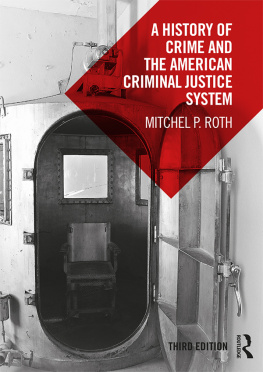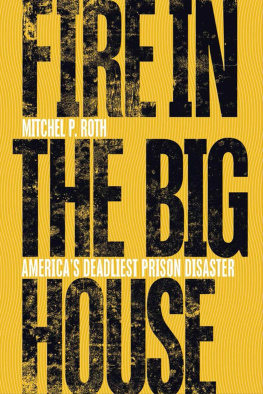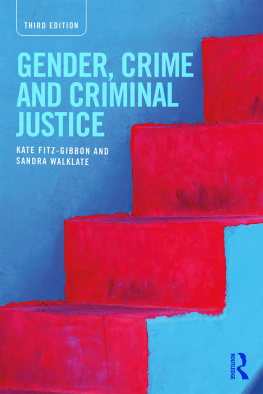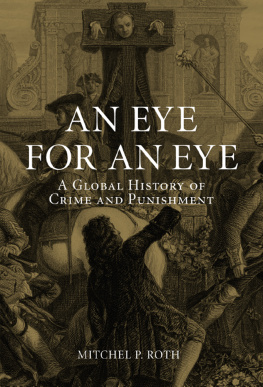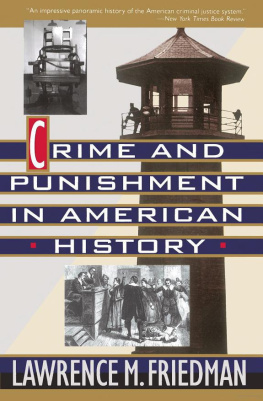A History of Crime and the American Criminal Justice System
This book offers a history of crime and the criminal justice system in America, written particularly for students of criminal justice and those interested in the history of crime and punishment. It follows the evolution of the criminal justice system chronologically and, when necessary, offers parallels between related criminal justice issues in different historical eras. From its antecedents in England to revolutionary times, to the American Civil War, right through the twentieth century to the age of terrorism, this book combines a wealth of resources with keen historical judgment to offer a fascinating account of the development of criminal justice in America. A new chapter brings the story up to date, looking at criminal justice through the Obama era and the early days of the Trump administration.
Each chapter is broken down into four crucial components related to the American criminal justice system from the historical perspective: lawmakers and the judiciary; law enforcement; corrections; and crime and punishment. A range of pedagogical features, including timelines of key events, learning objectives, critical thinking questions and sources, as well as a full glossary of key terms and a Whos Who in Criminal Justice History section, ensures that readers are well-equipped to navigate the immense body of knowledge related to criminal justice history.
Essential reading for Criminal Justice majors and historians alike, this book will be a fascinating text for anyone interested in the development of the American criminal justice system from ancient times to the present day.
Mitchel P. Roth is Professor of Criminal Justice and Criminology at Sam Houston State University, USA, and is the author of Global Organized Crime, 2nd ed. (Routledge, 2017).
Third edition published 2019
by Routledge
2 Park Square, Milton Park, Abingdon, Oxon, OX14 4RN
and by Routledge
711 Third Avenue, New York, NY 10017
Routledge is an imprint of the Taylor & Francis Group, an informa business
2019 Mitchel P. Roth
The right of Mitchel P. Roth to be identified as author of this work has been asserted by him in accordance with sections 77 and 78 of the Copyright, Designs and Patents Act 1988.
All rights reserved. No part of this book may be reprinted or reproduced or utilised in any form or by any electronic, mechanical, or other means, now known or hereafter invented, including photocopying and recording, or in any information storage or retrieval system, without permission in writing from the publishers.
Trademark notice: Product or corporate names may be trademarks or registered trademarks, and are used only for identification and explanation without intent to infringe.
First edition published by Wadsworth Publishing 2005
Second edition published by Wadsworth/Cengage Learning 2011
British Library Cataloguing-in-Publication Data
A catalogue record for this book is available from the British Library
Library of Congress Cataloging-in-Publication Data
Names: Roth, Mitchel P., 1953 author.
Title: A history of crime and the American criminal justice system /
Mitchel P. Roth.
Other titles: Crime and punishment.
Description: Third Edition. | New York : Routledge, 2019. | Revised edition
of the authors Crime and punishment, c2011. | Includes bibliographical
references and index.
Identifiers: LCCN 2018019020 | ISBN 9781138552869 (hardback) |
ISBN 9781138552883 (pbk.) | ISBN 9781315148342 (ebook)
Subjects: LCSH: Criminal justice, Administration ofHistory. | Criminal justice,
Administration ofUnited StatesHistory.
Classification: LCC HV7419 .R67 2019 | DDC 364.973dc23
LC record available at https://lccn.loc.gov/2018019020
ISBN: 978-1-138-55286-9 (hbk)
ISBN: 978-1-138-55288-3 (pbk)
ISBN: 978-1-315-14834-2 (ebk)
Typeset in Adobe Garamond and Parisine
by Apex CoVantage, LLC
This book is dedicated to my incredibly supportive wife, Ines and my son Eric, who inspires me to be a better person every day.
This text is a history of crime and the American criminal justice system. The author has published eighteen books, many combining the disciplines of history, criminal justice, and criminology. He has taught thousands of students over the past twenty years in courses ranging from the History of Murder and the History of American Violence to the History of Organized Crime and a Global History of Crime and Punishment. With a PhD in History, the author is a tenured professor in a leading criminal justice and criminology program. While there are several texts on the market currently, this is the only one actually written by a scholar schooled in historical research methods. The authors research and academic background has allowed him to appreciate what historical lessons are most germane to modern students seeking careers in criminal justice-related careers, especially those related to corrections, law enforcement, law school, policing, counterterrorism, and organized crime suppression, to name just a few. Moreover, this book offers lessons beyond the field of criminal justice and is also geared toward courses in the humanities as well as the general reader.
On the face of it, the book takes a traditional approach to chronicling the continuum of crime and criminal justice in America, as well as historical influences from antiquity and early British history. The text is organized chronologically, and when possible, offers parallels between criminal justice issues in different historical eras. This is exemplified by various discussions of regional variations in crime and punishment, xenophobia, discrimination, and so forth. There are certain themes that resonate through the sometimes troubled history of the American criminal justice system. Among the more recurring challenges has been the federal governments sporadic curtailment of civil liberties from the early Republic to the present including the Alien and Sedition Acts under President Thomas Jefferson, the suspension of the writ of habeas corpus under President Abraham Lincoln, the Red Scare of 1919, the internment of Japanese Americans during World War II, the era of McCarthyism, and controversy over the USA PATRIOT Act. In each of these cases, the criminal justice system has responded to real or imagined threats with strategies that made controversial tradeoffs between reduced civil liberties and national security. This is just one of the histori cal themes that appears throughout the book.
Writing a history of the criminal justice system is a challenging task. With such a wealth of sources to draw from, it requires a certain historical judgment as to what to include and what to leave out. Since a history of all criminal justice systemsvarious crimes and the current American criminal justice system, which is rooted in Old Testament ethics and morality, English antecedents, and the peculiar conditions of American history.
Each chapter is broken down into what the author considers five crucial components related to the American criminal justice system from the historical perspective, components that largely explain the evolution of a peculiarly American reaction to crime and crime control. Each chapter begins with a section on lawmakers and the judiciary, before delving into sections on law enforcement, corrections, and crime and punishment. It is the authors contention that an understanding of American criminal justice history should be rooted in the political, economic, and social patterns of American life. These are often explained in terms of race relations, immigration, economic dislocation, and certain regional predilections for violence and capital punishment (the South) or for order and capital punishment abolition (New England). When possible these issues and others are brought into play to help explain the continuum in crime and criminal justice patterns that exists in all regions of the country.

